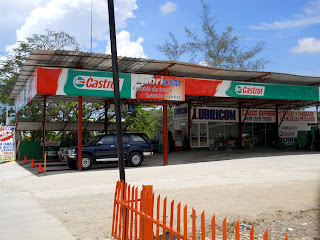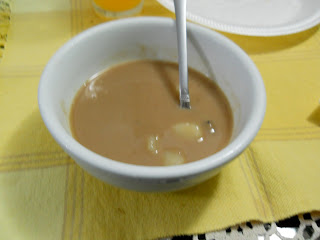So, we'll start our tour here, by the front door of my apartment, with the small patch of shrubs that my host mom grows next to it.
 After we leave the parking lot of my apartment building, this food stand is the first thing we pass. It's closed for most of the day, but around six in the afternoon the people who run it start setting up shop by putting chickens to roast over charcoal in the red box and pulling plastic chairs alongside it to peel plantains for frying later on in the evening.
After we leave the parking lot of my apartment building, this food stand is the first thing we pass. It's closed for most of the day, but around six in the afternoon the people who run it start setting up shop by putting chickens to roast over charcoal in the red box and pulling plastic chairs alongside it to peel plantains for frying later on in the evening.
Grossly close to the food stand are these dumpsters (For perspective: I think I stood in exactly the same place for both the last picture and this one, just turning around to the other direction). Sometimes, these dumpsters are emptied and the heap of overflow garbage is swept up and this looks like a normal sidewalk (albeit with a few more banana peels, shreds of old rags, and Oreo wrappers stuck to the ground than most). But once or twice a week, the trash piles up for two or three days at a time and forms a mountain four feet tall and twenty feet long - from before the edge of the first dumpster to beyond the edge of the third one. As this is a hot, humid country in the middle of the Caribbean, this is even grosser than it would be in, say, Minnesota, because the trash starts to rot and reek almost as soon as it's thrown on top of the heap. On the plus side, I've gotten really good at holding my breath while striding very quickly past it, which I imagine must be great exercise for my lungs.
 Next, we come to the motoconcho stand. At any given moment, there are at least a few men under the red awning, sitting on their motorcycles or driving them around in circles, offering to drive you anywhere in the city for around 20 pesos (50 cents). Since motoconcho are generally only safe in smaller towns, I have never taken one of them in Santiago. I have, however, received numerous marriage proposals from the drivers, generally with such romantic and charming lines as "Oye, mujer! Cásate conmigo y dame la visa!" ("Hey, woman! Marry me and give me a visa!").
Next, we come to the motoconcho stand. At any given moment, there are at least a few men under the red awning, sitting on their motorcycles or driving them around in circles, offering to drive you anywhere in the city for around 20 pesos (50 cents). Since motoconcho are generally only safe in smaller towns, I have never taken one of them in Santiago. I have, however, received numerous marriage proposals from the drivers, generally with such romantic and charming lines as "Oye, mujer! Cásate conmigo y dame la visa!" ("Hey, woman! Marry me and give me a visa!"). Cultural note: Lines like that are called piropos, and are a large part of, well, any experience any time any woman in the country leaves her house to go anywhere. They're usually called out from a respectful distance and sometimes they're a little funny or sweet, but they do get old. Examples of typical piropos include: "Psst! Psst!"..."Hola, bonita! (Hello beautiful!)"...The classic cat-call whistle..."Que Dios te bendiga (God bless you)"..."Rubia rubia!/Morena morena!/Negrita negrita! (Girl with light/medium/dark skin, respectively)"...and, if you look like you speak English, "Baby, I love you! I love you!" in the super thick accent of someone whose knowledge of that language consists only of that phrase.
 Moving on, we come to the smiley and frequently tipsy man who sells the staple vegetables of the Dominican diet - plantains, yucca, potatoes, tomatoes, and peppers - off of a tarp on the sidewalk.
Moving on, we come to the smiley and frequently tipsy man who sells the staple vegetables of the Dominican diet - plantains, yucca, potatoes, tomatoes, and peppers - off of a tarp on the sidewalk.And, across the street, there is this woman selling cigarettes, candy (including the beloved Halls cough drops), and coffee. While I have never bought anything here, I was once in a concho whose driver pulled up alongside the stand and asked the woman for a cup of coffee (served out of a large thermos into a tiny plastic cup, just barely bigger than the ones that come on the top of liquid medicines so you can measure your dosage) and one cigarette (which she pulled out of a brand-new pack for him, to sell the rest one at a time or all at once at a slightly reduced rate).
Moving along, we come to the newly built car repair/wash station. When I got here, this was just a layer of concrete with a few holes in the ground - now, it's a fully functional auto tune-up place trying to drum up business with all kinds of deals, like a free car wash with every oil change. So next time you're in town and need an oil change, you know where to go.
Next, we come to the bridge, a place I have very mixed feelings about. We'll start with this side of the bridge, as it's the one I use most of the time. As you can see, it's not the best-maintained. Not only is there this graffiti, but, behind that yellow wall...
...there's a large, frequently smelly pile of plastic cups, napkins, and grocery bags.
Once you get past that, though, you get this incredible view of a valley, a river, and a set of bright green plantain trees. Except for the gas station in the upper right corner, it looks like something out of National Geographic - and I get to walk past and admire it every single day.

There are also these plants, which I'm rather fond of. I've only ever seen them grow under this pipe on this bridge, so I'm not sure what they're called, but they're quite unusual. They're a grayish-purpleish color and are made of thick trunks with pointy leaves growing out in a circle. These two are pretty straight, but some of them grow out to the side at weird angles. Up until last week, there was one that was very low-to-the ground and grew almost horizontally, with a bend in the middle. Every time I saw it out of the corner of my eye, my heart skipped for a second, thinking it was a snake.
 The the other side of the street, even though it's technically the exact same bridge, is really different. It, too, has a nice view from some angles - here, you can look out and see the huge monument that's the center of the city of Santiago.
The the other side of the street, even though it's technically the exact same bridge, is really different. It, too, has a nice view from some angles - here, you can look out and see the huge monument that's the center of the city of Santiago. But it also houses one of the city's poor barrios, filled with tiny one- or two-room cement shacks topped with tin roofs with holes in them. The houses are built one next to the other wherever there's space, so there are sometimes nothing except foot paths leading up to them and, while a lot of them get electricity and water occasionally, those services are quite unreliable. There also isn't a garbage pick up for that neighborhood, so, as you can see on the left, a lot of it just ends up getting thrown down the side of the hill.
But it also houses one of the city's poor barrios, filled with tiny one- or two-room cement shacks topped with tin roofs with holes in them. The houses are built one next to the other wherever there's space, so there are sometimes nothing except foot paths leading up to them and, while a lot of them get electricity and water occasionally, those services are quite unreliable. There also isn't a garbage pick up for that neighborhood, so, as you can see on the left, a lot of it just ends up getting thrown down the side of the hill. This is the general store at the edge of the bridge, pieced together with a lot of tin, but selling a surprisingly wide variety of things, from tires to plastic kids toys.
This is the general store at the edge of the bridge, pieced together with a lot of tin, but selling a surprisingly wide variety of things, from tires to plastic kids toys.  Past the bridge comes a very different, solidly middle class area of town, with significantly less garbage on the streets and more far more chain stores. Here, we see the signs for PriceSmart and Payless...
Past the bridge comes a very different, solidly middle class area of town, with significantly less garbage on the streets and more far more chain stores. Here, we see the signs for PriceSmart and Payless......and a little later we come to the nicely air conditioned strip mall with Cecomisa (the primer computer repair shop in the country) and at least three separate Dominican banks.
 In between them is what is probably my favorite part of the walk - the fruit stand. Every day, on the back of his pick-up, this man lays out huge piles of fruits: bananas, pineapples, oranges, papayas, and, now that they've just started to come into season, mangoes. Because of all the citrus, it smells wonderful. It's also one of the more happening parts of the walk - every morning, the vendor sets out six or seven plastic chairs on the sidewalk alongside his truck, so that after buying their fruit, people can sit down, eat it, chat with each other, and (of course) call out piropos to women passing by.
In between them is what is probably my favorite part of the walk - the fruit stand. Every day, on the back of his pick-up, this man lays out huge piles of fruits: bananas, pineapples, oranges, papayas, and, now that they've just started to come into season, mangoes. Because of all the citrus, it smells wonderful. It's also one of the more happening parts of the walk - every morning, the vendor sets out six or seven plastic chairs on the sidewalk alongside his truck, so that after buying their fruit, people can sit down, eat it, chat with each other, and (of course) call out piropos to women passing by. This is my second favorite part of the walk. Every day, from eight in the morning to six at night, either the man in the white shirt and/or his brother are here, selling gorgeous flowers of all kinds - daisies, roses, birds of paradise - out of old paint buckets. I think, at some point or another, I've walked past every single stage of the operation, from setting up the paint buckets in the early morning to trimming the bottoms of the stems at midday to pouring water over them to keep them looking fresh in the afternoon to moving the more sensitive types of flowers from one part of the sidewalk to another to keep them in the shade as the sun moves across the sky.
This is my second favorite part of the walk. Every day, from eight in the morning to six at night, either the man in the white shirt and/or his brother are here, selling gorgeous flowers of all kinds - daisies, roses, birds of paradise - out of old paint buckets. I think, at some point or another, I've walked past every single stage of the operation, from setting up the paint buckets in the early morning to trimming the bottoms of the stems at midday to pouring water over them to keep them looking fresh in the afternoon to moving the more sensitive types of flowers from one part of the sidewalk to another to keep them in the shade as the sun moves across the sky. And, just a few yards past the flowers, we arrive at Puerta Dos (Gate 2) of my university, la Pontificia Universidad Católica Madre y Maestra! Were this a real walk, it's likely you now would have walked for fifteen minutes at a normal pace (ten at an "oh shoot I'm going to be late for class" one), would be feeling your shirt start to stick to your back with sweat, and would probably have gotten at least three piropos (if you're a woman).
















































